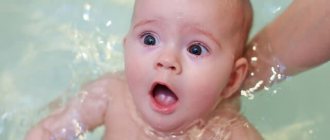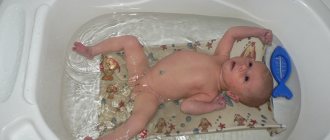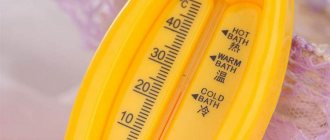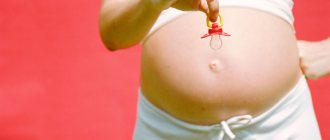A baby's first bath at home is an important event for both the baby and the parents. Everything related to the baby worries mom and dad very much, so a number of questions arise: what kind of water to bathe a newborn baby in, is it necessary to boil the water to bathe a newborn, should the wound on the navel heal and the umbilical cord fall off before water procedures, what are the conditions? are necessary for a comfortable pastime for the baby, and what difficulties may be encountered.
Baby bathing
Bath time
The famous Russian pediatrician, Dr. Evgeniy Komarovsky, constantly repeats in his works and videos that the baby should feel safe in the bathroom, splash around with pleasure and good mood.
The very first bath should not be too long; the usual duration is 3 minutes. After a month, the duration becomes about 15 minutes.
Important! If a quarter of an hour has passed, and the baby feels comfortable and wants to continue bathing, then the procedure can be extended.
Doctors insist on daily bathing, especially when the baby begins to crawl and actively explore the world. If parents are comfortable bathing their baby not in the evening, you can always find a suitable time for water activities, for example, at lunch or in the morning. However, before going to bed at night, bathing is more beneficial - it relaxes the body, preparing it for rest.
What you need to bathe a newborn
In addition, for the procedure you need to prepare the room in which the newborn will be located. The room should be warm and there should be no drafts, but if everything takes place in the bathroom, then you should leave the door open. The main thing for the mother or father is to remain calm, which will be passed on to the baby and then the event will take place without complications.
If we briefly look at what is needed for bathing a newborn baby, we will get a short list.
- You can put a sponge in the bath, which makes the process more comfortable for the baby.
- For convenience, the container can be placed on a stand, which will allow you to adjust the height, relieve the lower back and free up your palms. In addition, this stand can be used as a clothes dryer.
- The basin must be washed thoroughly before and after ablution.
- To communicate with a newborn, it is recommended to talk to the baby, tell various nursery rhymes, rhymes and sing songs while bathing.
- Water thermometer.
- Towel and clothes for the baby.
- Bathing products.
- Products for bathing babies.
- Herbal decoction or potassium permanganate solution.
What water to swim in
Is it necessary and worthwhile to bathe a newborn only in boiled water? This question worries many mothers. In the modern world, people quickly adapt to conditions, so tap water is familiar to many. The little miracle wants to choose something that will not be dangerous to his health.
Is it necessary to boil water?
How to potty train a child
Do I need to boil water to bathe my newborn? Most pediatricians agree that boiling water, if appropriate, is only for babies a few days or weeks old. Subsequently, you can and should switch to tap water.
Note! Boil the water thoroughly and add a solution of potassium permanganate when bathing - these rules have been known since the times of the Soviet Union for those children whose umbilical cord has not yet fallen off. However, Evgeny Komarovsky opposes potassium permanganate, recommending replacing it with an infusion of string. You can bathe your baby with an unhealed umbilical wound, but the doctor also recommends boiling the water.
Water temperature
Doctors have different opinions on what temperature of water to bathe a baby in. It is better to stick to 37 degrees during the first two weeks, and after that experiment with indicators of plus or minus.
Additional Information. There is no need to heat the bathroom. The air temperature should be, as in the entire apartment, 18-20 degrees. Pediatricians recommend swimming in cool water - 28-30 degrees, for which the baby should be prepared for the first 2 months. Then he will sleep stronger and more peacefully at night.
Is it possible to bathe in running water?
When can a baby start bathing in running water? As soon as the umbilical cord dries up. This way the baby quickly adapts to the environment and the bacteria that live in it.
Important! It is recommended to check the hardness of the liquid; it is better to install cleaning filters that will soften it and remove harmful impurities.
How to bathe a newborn baby
- Daily splashing is an obligatory item in the baby’s routine, but what should you do if he falls asleep in the evening, is it possible to wake him up? If this is an isolated case, then you should not wake up the baby, but if this happens constantly, then it is preferable to adjust his regime to include a visit to the shower room.
- Fill a bath of water (temperature +37 ºС). It is necessary to take into account the time of year and air temperature. When filling the bath with water, it is necessary to stir it periodically to ensure uniform heating. To determine the temperature, it is appropriate to use a water thermometer. The volume of water is such that it slightly covers the body, and the head is open.
- When using herbal decoctions or potassium permanganate solution, add them after filling the bath.
- Wash your hands well with soap, remove rings and bracelets so as not to scratch the baby. Set the time according to the duration of the baby's bathing.
- Carefully undress the baby and slowly immerse the baby in the water. For a more comfortable stay in the water, you can use a diaper. Gradually getting wet, it will wrap the baby, he will be calmer, like in his mother’s tummy (adaptive bathing of a newborn).
- When bathing a newborn, the door should be slightly open for a more comfortable stay for the baby in the water.
- It is better to bathe the baby together. It’s safer this way, because... The baby twitches actively, and is also soapy. If this is not possible, then you can use various devices for bathing a newborn, for example, a hammock can come to the rescue. Additionally, bathing together, when the mother and father are in the bath together with the baby, strengthens the connection between them, pacifies and makes the process more interesting.
- New parents are afraid that their baby will drink water from the bath, but there is nothing to worry about.
- Young parents are wondering how to hold their newborn while bathing so that it is safe and comfortable. In a large swimsuit, you can support the baby only under the head, allowing the body to hold up on its own, or hold your fingers under the neck and armpits.
- To prevent the baby from slipping out, you need to grab the shoulder farthest from you and hold the hand in the armpit. Back of the head on the wrist. The other hand under the butt. In this position, lower and remove the baby from the water. After immersion in water, the legs can be left free.
How to bathe a newborn baby. Photo: rodivnizze.ru
- To wash, you can use a stream from the tap, how to hold a newborn - lay on your left wrist, face up, holding the leg with your fingers, and wash with the other.
How to properly hold a newborn under a tap. Photo: my-sunshine.ru
- At first, you can carry out adaptation bathing for the baby several times, which will help you get used to the new conditions. To do this, he is wrapped in a diaper and bathed directly in it, so that he plunges into a state close to being in his mother’s stomach.
- With your free hand, wash the baby: neck, chest, stomach, arms, armpits, legs, inguinal folds, back, and at the very end the head. Rinse all folds thoroughly and unclench your fists.
- Rinse the perineum very thoroughly. In girls: folds between the labia. For boys, carefully wash the penis without moving the foreskin, scrotum, and then the area around the anus.
- Wash the head carefully, holding it with your hand and tilting it slightly. Pour water from the face to the back of the head. Rinse the folds behind the ears. To teach your baby to hold his breath and swim, you can pour water from the back of the head onto the forehead while bathing the newborn, using the marker words “attention” or “one, two, three” (you can come up with it yourself).
- Water the little one using a bathing ladle after ablutions (the temperature in it is 1 degree lower than the water in the bath).
- The frequency of bathing the baby does not depend on the degree of contamination; it is advisable to wash the newborn daily. At 2-3 months there is no need to use any cream, gel, soap or shampoo, if the baby is not dirty with feces, a warm stream from the tap is enough.
- After discharge, the baby remains with a clothespin on his navel, and many parents doubt whether it is possible to bathe the newborn with it. This issue should be resolved together with a pediatrician; if you decide to hold the event, then it is enough to follow the rules: heat the water to 37 degrees; Boil the water so as not to lead to suppuration. Is it possible to wet the navel and what to do if it gets wet, it is advisable to wait until it dries, gently blot it with a cotton swab and apply peroxide or brilliant green.
- To cleanse the skin of a newborn, you can take a bathing sponge, which will gently cleanse, provide a light massage and will please the baby. It can be used either alone or with a baby bath product.
- If water gets into the baby’s ear while bathing, do not be alarmed; first, place it on one side so that the liquid flows out, and then on the other. You can use cotton swabs to check for dampness in the ear canals. To avoid colds, it is advisable to put on a cap or cap for your child.
- The bathing time for the first time is from a few minutes to 15, as you get used to it. After a month, you can increase to 20-30 minutes.
Important! If a baby's nasolabial triangle turns blue, it is advisable to observe it. Children have very delicate and thin dermis, through which blood vessels appear, so in some cases turning blue is a natural reaction to stress, for example, when crying for a long time. If accompanying symptoms appear, for example, wheezing when breathing or a runny nose, it is advisable to contact your pediatrician to find out.
What to add to water
Gymnastics for a 6 month old baby
All bath additives should be discussed with your pediatrician. If grandmothers recommend adding nine forces, then you should not immediately put this into practice. If atopic dermatitis, diaper rash, or allergic reactions are detected in the baby, then consultation with a doctor cannot be avoided.
Herbs or bath products
For a healthy child, adding medicinal herbs to the bath is beneficial. Remember to take into account the dosage and do not use them daily.
Herbs for bathing a newborn
Important! Medicinal herbs will not cure any disease. This will most likely add useful properties to the procedure.
If the choice fell on bathing products, then the best solution would be a small amount of sea salt or its solution. Cosmetic preparations can often cause allergies in infants.
Bübchen baby bath
Herbs for prevention
Grandmothers often try to pour a liter or two of medicinal herbal decoction into their granddaughter’s bathtub – “just in case.” You shouldn’t do this unless there are obvious reasons and doctor’s recommendations, says Tatyana Vladimirovna. Herbal decoctions are not harmless
- if there are cases of allergies in the family, the baby may react to some kind of herb with an allergic reaction.
But on the other hand, there are herbs with a drying, soothing, anti-inflammatory effect that can help. Please consult your doctor regarding this matter. A calming effect can be achieved without herbs - water slightly warmer than 37 degrees
relaxes little screamers even without any valerian. Water that is slightly cooler than the set temperature, on the contrary, invigorates and tones – after such a bath the baby is unlikely to immediately go to sleep.
Rules for bathing a baby
How to develop a child at 4 months - educational games and activities
To bathe your baby, you need to buy certain accessories in advance. Extra equipment in the form of rubber toys is not useful.
The most important accessories:
- Bath. Komarovsky insists that you will first need a small plastic bath - for the first months. The baby will be comfortable in it, and the parents will be calmer. If the hot water supply is turned off, such a bath is easier to fill and subsequently wash.
- Water thermometer.
- Soap (does not need to be used daily).
- Towel.
- Slide or hammock. They will come in handy if the mother bathes the baby alone.
Bath time
Start with three minutes, the very next day you can make the event twice as long. The most comfortable time is 15-20 minutes. It is important to monitor the baby’s condition and stop water treatments if he feels discomfort.
Air temperature
You should not bring heaters into the bathroom, thinking that this will make your baby comfortable. The air temperature should be between 18-20 degrees - this is the most optimal indicator for the child’s comfort.
Evgeniy Olegovich recommends opening the bathroom door when bathing so that the air does not stagnate, steam escapes, and the water slowly cools.
Algorithm of actions
After all the necessary equipment is prepared, you can begin water procedures:
- Pediatricians recommend a massage so that the muscles are supplied with blood and the skin is prepared for bathing. The massage should be light and relaxing.
- The bathtub must be clean.
- Before immersing the child in the bath, the parent dips his or her own elbow into the water.
- The baby is placed in the water slowly, smoothly, and allowed to get used to it. If the baby is worried, do not immediately take it out of the water. First you should try to calm him down, splash him quietly with some water.
- Lather the baby. Sponges and washcloths are not needed; they can scratch the skin.
- Douse the baby's body with a liquid that is one degree less than that in the bathroom.
- Dry the body with a dry diaper or towel; do not rub it.
Correct position of a child in your arms
How long can a baby bathe?
It is better not to keep your baby in the bath for more than half an hour. In some cases, he may start playing in the bathroom, frolicking, so much so that he subsequently cannot sleep.
What to put on the bottom of the bath
If it is too slippery, then a special mat will not hurt. You can buy this in specialized stores.
Mini bath mats
Preparing for a swim
In order for the bathing procedure to be successful, prepare everything you need in advance (I will say more about this below). It would be nice to call someone older for help (a grandmother, for example, or even an experienced neighbor). It would be wonderful if the father took part in all matters from the first day, including helping to bathe the baby - after all, from the very first days, the child needs to feel the love and care of both parents, and the father, holding a tiny creature in his arms, gets all this will help you feel more courageous and responsible. In addition, it has been established that the earlier the father begins to take part in all activities related to the care and upbringing of the child, the stronger the relationship between them becomes in the future.
So, before you start swimming, prepare everything you need in advance.
Firstly, water.
The fact is that the child is bathed only in boiled water until the umbilical wound heals (this usually happens at the age of 18-22 days), so the water must be boiled in advance so that it gradually cools down to 38°C.
Secondly, the premises
where you will bathe must meet several requirements: be warm (air temperature 22-24°C), free from drafts, and be comfortable so that you can approach the bath from all sides. Many people bathe in the bathroom, placing the baby bath on a stand, but, in my opinion, it’s more convenient to do this in the kitchen, where you can heat the air well, put the bath on the dining table (and then you won’t have to bend over to hold the baby), and , besides, the kitchen is usually much lighter.
Thirdly, you should prepare your clothes in advance
, in which you will dress the child after bathing, usually these are: 2 diapers (thin and thick), 2 vests (thin and thick), a diaper, a cap. All this must be laid out on the changing table in advance in the order in which you will need it.
In addition, you also need a 1.5-2 liter jug for pouring, a soft towel, baby soap, cotton wool, boiled vegetable or petroleum jelly, powder; brilliant green and a 3% solution of hydrogen peroxide to treat the umbilical wound, and finally, prepare a highly concentrated solution of potassium permanganate in a small bottle (you will drop a few drops into the bathing water until the umbilical wound heals), 2 pipettes.
What is hard water?
To talk about water softening filters, you need to understand what and why it needs to be purified. In the last article, we already looked at several methods for softening hard water, and now let’s move on to the concepts. What signs of hard water can tell a consumer that this is it?
| Harmful impurity | Characteristic signs |
| Calcareousness | Scale formation on the walls Poor wash quality Poor solubility of detergents White stains on clothes that are difficult to wash The barely perceptible bitterness of the water |
There is always a risk of confusing the effects of lime water and chlorinated water, because... the second leaves stains on clothes in the same way and spoils both the color of the water and the quality of the wash. But chlorinated water does not leave scale on the walls. And they can be confused because at the initial stage there is nothing on the walls of the equipment. And the whitish coating is confusing.
Calcareous water, or as it is also called hard water, refers to water that contains a large amount of salts. Moreover, the quantity exceeds the maximum permissible. And then the water is called hard. Such water is measured in milligrams per equivalent meter. The concept of hard begins with seven, and water with an index of eleven is considered very hard. There are many ways to soften water, but not all of them are cheap or convenient.
Why is lime water considered such a negative phenomenon? The problem lies in the operation of the device after scale settles on the surface. Plaque has blocking properties. When such a surface is heated, it is almost not transferred further into the water. It turns out that heat begins to accumulate in the surface material, gradually destroying it. And sooner or later, the surface will react to the accumulating heat. This could be a crack in the bottom, or it could be a fluid condition. In any case, the device will be hopelessly damaged. And this does not include the costs of working with such water. And this includes illnesses, excess consumption of water, detergents, damaged fabrics and boiled vegetables in borscht. So poor quality water is the cause of many problems. Humanity has long been thinking about solving this problem. This is how filters were invented.
What should the water temperature be?
In order for the baby to be comfortable, the water temperature should be about 36-37°C. The water temperature should be measured with a water thermometer. You should not rely on your own sensations when determining the temperature with your elbow - the perception of temperature is individual. At a higher temperature, the baby may overheat, which, as a result, will manifest itself in the form of anxiety, sleep disturbances, or, conversely, lethargy. After 1 month, water procedures can already be combined with hardening. Then they begin to gradually reduce the water temperature by 1 degree every one or two weeks, bringing it to 28-30 °C.
Newborn bathing products
After bathing the baby for the first time after being discharged from the hospital, mothers and fathers wonder whether it is necessary to use soap or shampoo. Doctors recommend using them only to clean dirt, for example, foam for newborns.
- The French brand Mustela has developed a bathing gel that is suitable for use from the first days of life and is hypoallergenic. It cleanses the skin, softens it, prevents it from drying out and does not cause irritation.
- Weleda is a manufacturer of organic cosmetics and they have released a series of products suitable for children that soften, relieve inflammation, and promote healthy sleep.
- Emolium is suitable for use in very dry dermis and is indicated from the beginning of life. This remedy is suitable for infants with atopic dermatitis, psoriasis or other skin diseases.
- The German company Bübchen has been collaborating with pediatricians for years, collecting important information and inventing cosmetics specifically for newborns. It does not cause irritation, soothes inflammation and improves immunity.
- In addition, some people use potassium permanganate for bathing babies, so you need to know how much to add. How to properly dilute potassium permanganate for bathing a newborn: DO NOT throw crystals of the substance into the bath; Place 5-7 crystals in a glass, add hot water (does not dissolve in cold water); stir until the crystals dissolve completely; strain through cheesecloth; check if there are any crystals left at the bottom. The solution is pink-violet. Carefully add to the bath without a child, making sure that the water turns a uniform, slightly pink color. There are both opponents of this method and defenders, some claim that the solution disinfects the epidermis, promotes healing of the umbilical wound, fights diaper rash, while others claim that it is poison for the child’s body.
Interesting fact! Dr. Komarovsky clearly stated that bathing a newborn in a solution of potassium permanganate does not bring much benefit, but can lead to burns of the mucous membrane and poisoning if this remedy is not diluted correctly.
What to do after bathing your newborn
- After bathing is finished, gently pat the skin dry and wrap it in a towel with a hood or corner that will protect the baby from colds.
- All folds must be dried well.
- Treat the umbilical wound.
- After bathing, be sure to smear the baby’s epidermis with something, such as cream or oil. In addition, it is important to carefully treat the baby’s folds and lubricate them with powder, oil or cream to avoid diaper rash. Children's cream and Bepanten ointment are well suited for these purposes.
- If a newborn's skin peels after bathing, it is advisable to abandon the potassium permanganate solution and cosmetics, and after the procedure use oil and cream that will soften and moisturize the layers of the dermis.
- After drying, put on the newborn a cap, a diaper and wrap him in warm diapers. It must be remembered that the baby holds the temperature for about 15 minutes. Do not remove the cap until the hair is dry.
- Then you can feed the baby and put him to bed.
Interesting! The best tips for caring for young children before, during and after taking a bath were provided by the Russian Pediatricians Union in their recommendations for skin care.
Methodological recommendations Skin care for a newborn baby
Devices for bathing a newborn
Bath
In some cases, a bath for bathing a baby is not the best option, because... the child begins to cry and worry. In this case, a special small bath for a newborn is suitable - this is the best option, because the baby is in a limited space, like in a mother’s stomach, and feels safe.
- A bathtub with a stand makes life easier, because... it will be at the right height, it will be enough just to place a chair and sit next to it for washing.
- The folding design is convenient and easy to use, safe, takes up little space, and can be taken with you to the country house or on a trip.
For regular baths, you will need special inserts that will make the process of washing a newborn easier.
Bath for bathing a newborn. Photo: profilaktika.tomsk.ru
Slide
The plastic slide is easy to use because... the anatomical shape follows the curves of the body, the baby sits tightly in it and this does not cause him any discomfort, and the person’s palms will be free. At what age can you use a slide for bathing a newborn - from birth, because... it is safe, prevents the baby from falling out and gives the opportunity to control the situation.
There are also fabric slides for swimming - they are a metal frame on which fabric is stretched. However, many parents prefer plastic or anatomical ones, because they are safer, the crumbs do not fall out of them or slip.
Circle
Not long ago it became popular to wear a circle for babies. At what months can a newborn be bathed in a circle? Doctors advise starting to use the device at 1.5 months.
Before putting the circle around the newborn’s neck for bathing, it is useful to introduce it to it; for this, you can let it touch it, and then put it on. How to wear a circle:
- carefully, open the latches on the back;
- put on the neck;
- bring the parts together and adjust the fit so that there is some space left;
- the chin should lie in a special recess.
Even though it is safe to bathe a baby with a ring on his neck, it is not advisable to leave him alone in the room, even for a short period of time. Young parents are also concerned about whether such a circle causes harm to the newborn. If a high-quality product is chosen, then its use will only bring benefits, because this improves and enhances its development.
Circle for bathing a newborn. Photo: kpoxa.info
Hammock
There is a hammock to keep your hands free while bathing your baby. It consists of a durable mesh, which is attached to the structure using strong hooks and supports the baby during the entire process without hindering movement.
Mattress
For bathing in large quantities, you can use a mattress that has an anatomical shape, floats perfectly and can support a child weighing from 3 to 8 kg. You should not use oil-based cosmetics while bathing your baby, and after the event the mattress must be thoroughly dried.
cap
The baby cap is a cotton cap with foam inserts sewn on it. The essence of this headdress is to support the baby's head - this will affect his ability to stay in the waves and develop the muscles of his back and limbs. However, this does not mean that the toddler will not need to be supported, because he can roll over and swallow liquid.
You can buy a foam cap at any store, or you can make it yourself; it won’t require a lot of time and effort.
Cap with foam for bathing a newborn. Photo: ladysarafan.ru
Collar
A collar that fits around the neck and keeps it afloat in a large font, pool or sea is also suitable for bathing a baby. This device will last up to six months and will help the baby hold up her head, and then her body. However, you should be careful, because an inflatable collar can cause harm, for example, if the baby learns to reach the bottom with its legs, this will lead to a lack of coordination.
Sun lounger
Used to free your hands and make your child feel comfortable and safe. However, it is advisable to support the baby so that he does not slip or fall out. Despite the resemblance to a slide, the lounge chair is soft and pleasant to the touch.
Cushion and mesh
For swimming in a large bathtub, a bathing pillow is suitable for a newborn, thanks to which he will hold on, however, it is not advisable to leave the child alone, because. It's easy to slip off and drink water. For small volumes, a mesh is suitable, in which the baby feels comfortable, does not slip and holds confidently.
Filters and water softeners
What to do when there is a suspicion that the water is not of normal softness? The first step is to assess the condition of the water. A consumer can easily confuse different types of impurities, so it is better not to skimp at the stage of assessing the condition of water. Its purpose is not only to find out what impurities are in the water, but also to determine their composition and size. Thus, determine which water softening filter is most suitable. After all, you can take a low-power device, spend money on it, and as a result not get the desired soft water.
Water softeners today include:
- Vinegar essence;
- Lemon acid;
- Soda;
- Special filters: electromagnetic (non-chemical) and ion exchange (chemical);
- Simple boiling.
There aren't many of them. There are a couple more options to get soft water. To do this, you will have to freeze or boil it. And the water will also be soft, but all traces of heating will remain on the surface of the pan or kettle. And then you will have to clean them, like any other surfaces. The remedies are temporary help and rather preventative. You should not rely on them as a means of removing scale. This is prevention, prophylaxis.
Now directly about filters. How can you soften hard water without worrying about the consequences? Only by installing a high-quality softening system. To do this, you need to compile it based on the results of assessing the state of the water. It will clearly indicate what the flow rate is in the apartment and how much the family uses approximately of both technical and drinking water.
The best combination that allows you to consume both industrial and drinking tap water without problems would be a complex - an electromagnetic device plus an ion exchange device. The more expensive complex is the replacement of an ion exchange system with a reverse osmation system. But the task of such a system boils down to one thing: anywhere in the apartment, the water must be soft and any household appliance must work with soft water. So that the consumer does not have questions with washing his hair and bathing his child, the water should be soft in any tap.
Electromagnetic filter AquaShield
Why is he so highly praised and recommended?
And is there any fiction in such magnetic irradiation? A unique feature of magnetic irradiation is that when exposed to low-quality water, it does not clean it, but transforms it. Salts are transformed and in a new form, without changing their behavior at all, they begin to be beneficial. Becoming thin needles, they gradually rub old sediment on the internal surfaces of household appliances. Moreover, they do this so persistently that gradually the sediment begins to soften, loosen and lag behind the surfaces. The effect can be traced throughout the entire territory of the household appliance, because the electromagnetic field does not operate at a short distance, up to seven hundred meters from the installed appliance. And it cleans not only the internal surfaces of the same washing machine, but also the internal surfaces of the pipes that supply water to and from the system.
In this case, there is no water that needs to be drained, there is no sediment that needs to be drained, it is naturally removed from the system, and therefore such water cannot be used for drinking. The purified sediment remains in the water, but for household appliances it is no longer dangerous, but it is not suitable for drinking and must be filtered. That’s why it is recommended to combine filters.
Ion exchange filter
An excellent addition to an electromagnet is an ion exchange device. This could be a filter jug, or it could be installed under the sink. But nothing better has yet been invented to purify drinking water. Ideal cleaning quality, targeted directly at softening.
The filter stage is a cartridge filled with a unique water softener - enriched resin. It contains sodium, which is beneficial for water, which very easily, when in contact with water, gives way in the structure to lime salts. It turns out when washed, a natural reaction occurs and sodium-enriched, purified water comes out. And the consumer does not help this reaction in any way. Everything happens by itself.
But such cartridges quickly clog, especially if the water is too chalky. They are enough for no more than another month. We have to change them constantly. They cost a lot of money. One cartridge is almost a third of the cost of a water softener filter. The pleasure is not cheap, but the quality of softening is worth it. Because in water there is a clear replacement of some ions with others. In industry, such a device is a little more profitable, because the cartridge can be restored. When producing drinking water, only change it, because restoration occurs through a massive chemical attack. Is it possible to replace this spark plug with something? And is there any point in such a replacement? After all, water can be different and sometimes too soft water is needed in certain cases, for example, when bathing a child or washing hair.
Basic rules for swimming
Proper water procedures will help you get maximum benefits and not worsen your skin condition:
- Duration of stay in water is no more than 20 minutes. The water temperature should be pleasant for swimming, 37-38 degrees.
- If you have dermatitis, do not wash in water containing chlorine. Tap water will have to be boiled or a special filter purchased.
- Do not swim in pools, as the water there is usually chlorinated.
- It is advisable not to take a bath, but to give preference to a shower.
- You should not use washcloths, various brushes or scrubs, as this may worsen the condition of damaged skin areas.
- Also, you should not wipe or rub yourself; you can only blot your body with a soft towel.
All bathing products used must not contain alkaline or allergenic components.
What if water gets into your ears?
Many people are afraid to wet their baby’s ears, because they believe that water getting into the external auditory canal can cause inflammation of the middle ear - otitis media. The child lived in water for nine months of intrauterine life, so this environment is familiar to him and he is ready for the fact that water can get into his ears. There can be no harm from water getting into your baby's ears. Hypothermia after swimming is dangerous. To avoid it, it is enough to remove water from the ear canal immediately after bathing with cotton balls: insert a piece of cotton wool into the baby’s ear and wait until it absorbs the water.
Herbal decoctions to soften water
You can also use nettle infusion to soften water.
Remember that herbs such as chamomile or string relieve irritation on the child’s skin, but they also dry the skin, so firstly you need to take breaks from using them, and secondly, they can only worsen the condition of the skin if you use them constantly.
The so-called potassium permanganate only dries the child’s skin, so it is usually recommended to use it in cases where the child’s navel has not yet healed, and you do not have the opportunity to constantly boil water for the entire bath.
How to deal with a child in a large bathroom?
Bathing in a large bathtub makes it possible to teach your baby to swim from the first months. Physical exercise in water has a beneficial effect on the development of the baby, calms the nervous system and relieves hypertension. Supporting the child's armpits, lower him vertically into the water, then lay him on his back and, supporting him under his shoulders, move him back and forth through the water, drawing figure eights. The child will move his legs and torso, trying to stay on the water. Bring your baby's legs to the side of the bathtub and let the baby push off from it. Then you can do reflex walking: place the baby vertically so that he reaches the bottom of the bathtub, and tilt him slightly in front - the child will begin to walk. During the lesson, monitor your baby's reaction. If he starts to get nervous and tired, stop training.










